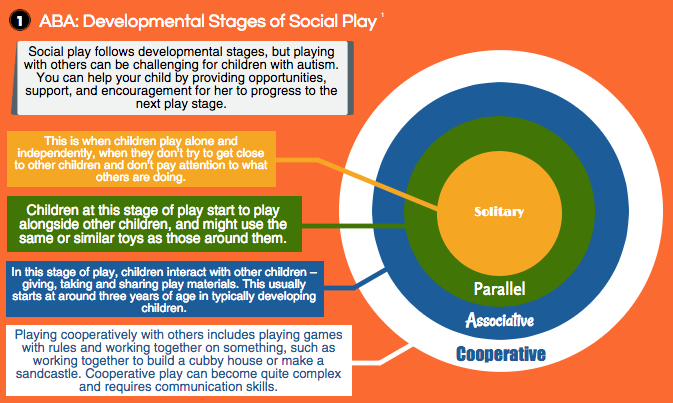First Leap Offers a Free 30 Minute Consultation
Developmental Stages of Social Play
Playing alone (solitary play)
This is when children play alone and independently, when they don’t try to get close to other children and don’t pay attention to what others are doing.
For children with ASD, you can encourage solitary play skills by starting with activities that have a clear goal and ending. Keep the play short to begin with, so your child can finish the activity quickly and feel successful. For example, you might choose a simple jigsaw puzzle.
Playing alongside (parallel play)
Children at this stage of play start to play alongside other children, and might use the same or similar toys as those around them.
You can promote play in this stage by encouraging your child to play at an activity − such as trains − on his own but alongside other children. You can encourage your child to imitate the other children’s play while he’s playing on his own.
Playing and sharing with others (associative play)
In this stage of play, children interact with other children – giving, taking and sharing play materials. This usually starts at around three years of age in typically developing children.
You can help your child with ASD learn skills for associative play by encouraging her to swap things while she’s still playing on her own – for example, swapping bikes, trikes or scooters when cycling or scooting with other children.
Playing and cooperating (cooperative play)
Playing cooperatively with others includes playing games with rules, making up rules, and working together on something, such as working together to build a cubby house or make a sandcastle. Cooperative play can become quite complex and requires communication skills.
Many of the social rules in this stage of play can be difficult for a child with ASD to understand. You can help your child by using clear instructions to simplify the rules of games. For example, ‘First you hide somewhere in the house. Then Sam counts to 10. Then Sam comes to find you. When Sam finds you, it’s your turn to count while Sam hides’.
It can also help to explain the rules using pictures or Social Stories™. Making games more visual can also help – for example, you can mark the person who is ‘it’ with a special hat.
Encouraging play with others for children with autism spectrum disorder
Once your child with autism spectrum disorder (ASD) has a range of play skills or is beginning to play with and take notice of other children, you can help him learn how to interact and play with others.
Simple games are a good way to build social interaction in play as well as turn-taking skills. Games such as peek-a-boo, pat-a-cake and ring-o-rosies are all social.
Here are some other ideas to get your child interacting and playing with others:
- Use play dates or visits with friends or family whose children are around the same age as your child. You could also ask your child’s siblings or cousins to help with showing your child how to play games, take turns and so on.
- Teach your child how to join in. Again, siblings, friends and cousins might be able to show your child how it’s done.
- If other children ignore your child, watch carefully and see whether you can work out why. Does she need to work on a skill that you can help her learn? You could speak to your child’s preschool or early intervention teacher if you’re not sure. Early childhood workers have lots of skills for helping children learn to play together.
Making the most of play with your child with autism spectrum disorder
Once your child with autism spectrum disorder (ASD) can play with you and is playing with toys, you can use play to build skills in other areas. For example, you might focus on rewarding certain skills like taking turns, playing for longer periods of time, or choosing a variety of toys to play with.
Here are some tips for making the most of play in this way. These tips apply to all kinds of play – toy play, playing with others and pretend play:
- You can build language by talking about what’s going on while your child plays. If you’re playing a pretend game such as a tea party, use the names of objects, such as cup, spoon and plate. You can also give words to the things you and your child are doing, such as ‘pour drink’ or ‘feed teddy’.
- If your child is speaking only in single words, you could try using two words. If he’s using three-word sentences, you can use four words, and so on. This way you’re not using language that’s too hard for your child, but you’re building up his language and vocabulary.
- Encourage play skills in different environments. Reward your child for using her play skills in different places and with different people.
- Use everyday activities as opportunities for play. Any time there can be joint activity between your child and another person is a potential chance for play. You can also build playtime into everyday routines like bath time.
- As your child’s play skills develop, you can begin to use play to help your child respond appropriately to social situations that he might find challenging, such as understanding social rules like sharing, turn-taking, compromise and negotiation. For example, you could use a tea party game to help your child understand sharing food and taking turns to pour a drink with the jug.
- Play can also help children with ASD develop everyday skills. For example, dressing a doll can help your child learn to dress herself.
Watch your child throughout the day and try to ‘catch’ the times when he shows interest in an activity, however mundane it might seem to you. These are the perfect times to teach and learn.
From: http://raisingchildren.net.au/articles/autism_spectrum_disorder_play.html


